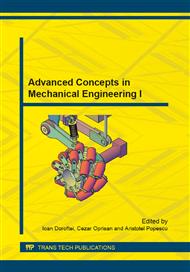p.632
p.638
p.644
p.648
p.654
p.660
p.666
p.672
p.678
Control Characteristics of Haptic Exoskeleton Elbow Module Used in Space Robotised Applications
Abstract:
In this paper the authors present some considerations regarding the necessity and the methods to calibrate an exoskeleton elbow module. Prior researches and studies are indicating that there is a difference between the haptic device force reaction and situation (position and orientation) and similar parameters at the level of the guided or slave robot. The authors are investigating the causes of the pose accuracy and force errors knowing the fact that for some space operations the fidelity of the teleoperation the geometric, kinematic and dynamic parameters are of great importance. The authors propose the measurement of the position accuracy, position repeatability, static relaxation under load, speed and acceleration, force and torque measurement in order to obtain a real correlation between the haptic device and the space robot parameters. Also the authors are considering the investigation of the unwanted vibration and the effect on the teleoperation parameters. Considering the importance of calibration for the improvement of the general accuracy of teleoperation the authors are taking into account the development of several performance indicators as a consequence of the conclusions emerged from the calibration methods study above mentioned. Also they consider very important that the calibration methods must be specific for each application category and therefore moderated performance indicators are envisaged.This template explains and demonstrates how to prepare your camera-ready paper for Trans Tech Publications. The best is to read these instructions and follow the outline of this text.
Info:
Periodical:
Pages:
654-659
Citation:
Online since:
October 2014
Keywords:
Price:
Сopyright:
© 2014 Trans Tech Publications Ltd. All Rights Reserved
Share:
Citation:


